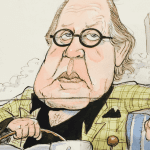IT HAS taken nine years, but Ferrari finally triumphed again at Monza in the hands of brilliant youngster Charles Leclerc. PETER COSTER reports:
THE FACE, the beak of a nose, it was as if Enzo Ferrari himself had come to join in the hysteria that enveloped the Monza circuit after one of “the bloody red cars” won the Italian Grand Prix.
The Commendatore may be dead but a younger version in his surviving son, Piero, was among tens of thousands of celebrating Tifosi.
Piero Ferrari at 74 looks much like his father, the imperious creator of motor sport’s most famous marque.
Dino Ferrari was Ferrari’s first son, who died of muscular dystrophy at the age of 24. Piero is the half-brother born to his father’s mistress, Lina Lardi.
He was not acknowledged as a member of the Ferrari family until Enzo’s wife Laura died in 1978, but his hand is on Ferrari as vice-chairman.
Such is dynasty, he lives in his father’s old apartment above Ferrari’s headquarters at Modena. The bloodline of the red cars remains unbroken.
Ferrari has been in Formula One since the first Grand Prix of the world championship was held in 1950.
One of the Scuderia’s greatest rivals, Tony Vandervell, owner of the Vanwall cars driven by Stirling Moss, called them the bloody red cars.
They had not won at Monza since 2010. The circuit where drivers once chanced their lives on its cliff-like banking, is still the world’s fastest circuit.
The 21-degree banking has gone but the circuit still calls for an absolute commitment by drivers.
On Sunday, that commitment was shown by first-year Ferrari driver Charles Leclerc.
His victory on Sunday was described by Mercedes boss Toto Wolff as “hard but brilliant”.
This was in spite of Leclerc “pushing Lewis off” the road when the Mercedes driver tried to pass him on the outside at the Roggia chicane.
Hamilton, the five-time world champion had put the 21-year-old rookie under pressure for more than 20 laps.
Leclerc moved marginally to the right at Roggia, forcing Hamilton on to the run-off area. Should he have left Hamilton more room, was a question that might have been put to Michael Schumacher who put Ferrari back on the podium after years of poor performances.
The seven-times world champion is in the Georges Pompidou hospital in Paris for stem-cell treatment after a skiing accident six years ago left him in a coma.
The German driver was ruthless and intimidating on the track. He would never have conceded ground.
Hamilton said he would not have given ground as he tried to pass unless he had been protecting his lead in the world championship.
But that was a day after he said the stewards might have reversed the rules after having “got out on the other side of the bed” that morning.
By all accounts the stewards got it right. Toto Wolff said he thought “we would have had riots here” had the race been taken away from Leclerc.
The comment might not have been entirely tongue in cheek. Passion runs high in Italy when the red cars and their drivers are called into question.
What Leclerc did in his back-to-back victory after Spa was exactly how Wolff described it. Leclerc had driven “a hard, brilliant race”.
The Monagasque is a world champion of the future, as are other young drivers, particularly Max Verstappen at Red Bull who won in Austria and Germany.
For Ferrari, Leclerc’s win was its first at Monza since 2010 when Fernando Alonso won the second of two victories.
Embed from Getty ImagesThe former double world champion was at the track on Sunday but could not be found for the after-race interviews.
“Fernando has left the track,” was the message, rather like, “Elvis has left the building.”
The Spaniard was probably trying to avoid the traffic back to Milan.
The crowd was ecstatic as Leclerc stepped out of his car and launched himself into the arms of the waiting pit crew and mechanics.
The Tifosi were joyous. Leclerc, faced with a post-race interview in English, asked if he might speak in Italian. The Tifosi went wild.
After Leclerc won the race he screamed repeatedly over team radio, “Mamma mia, Mamma mia.”
He might have added from the Abba song book, “Here I go again.”
Not so Sebastian Vettel. The four-times world champion has not won this year and has become Ferrari’s “second” driver, according to former Mercedes driver Nico Rosberg.
The 2016 world champion says Vettel has found himself “in a dark place” and will start in the next race in Singapore 13 points behind Leclerc in the world championship standings.
Vettel spun at Monza and hit Racing Point’s Lance Stroll when he drove back across the track. This cost him a 10-second stop-and-go penalty but could have cost him his life.
The German driver could have been rammed, much as befell Anthoine Hubert, Leclerc’s life-long friend, in a GP2 race at Spa, the week before Monza.
Juan Manuel Correa, who was driving the other car, is in a critical condition in hospital in London after respiratory failure.
At Monza, Leclerc’s steering wheel had RIP clearly visible across it as he drove towards parc ferme.
It was a grim, if macabre warning, that motor racing is dangerous. The last driver to die in F1 was Leclerc’s “soul brother”, Jules Bianchi.
The French driver died after a crash in the rain-soaked Japanese Grand Prix in 2014, when he slid into a mobile crane parked at the side of the circuit.
Leclerc said in a BBC interview after the Spa accident: “From the beginning when you go into this sport, you know how dangerous it is. It will never be a safe sport.”
But motor racing is safer than it was. In the 60s and 70s, several drivers died each year, sometimes each month.
Former triple-world champion Jackie Stewart, who was wearing his trademark Scottish trews at Monza, campaigned for race safety after losing his teammate Francois Cevert in a qualifying accident at Watkins Glen in 1973.
Many still followed, although the toll dropped off from the mid-1980s until triple-world champion Ayrton Senna was killed at the San Marino Grand Prix at the Autodromo Enzo e Dino Ferrari in 1994.
His death through a steering failure in his Williams came a day after Austrian driver Roland Ratzenberger died in a qualifying crash.
A shaken Senna was asked by F1 medical doctor Sid Watkins on the day of the Ratzenberger crash why he did not just stop racing and they would “go fishing together”.
Senna said he couldn’t stop. “I have to race.”
Much the same was said by Leclerc after the death of Bianchi. “There were no thoughts at any time to stop my career because of that.”
PETER COSTER is a former editor and foreign correspondent who has covered a range of international sports, including world championship fights and the Olympic Games.




Discussion about this post